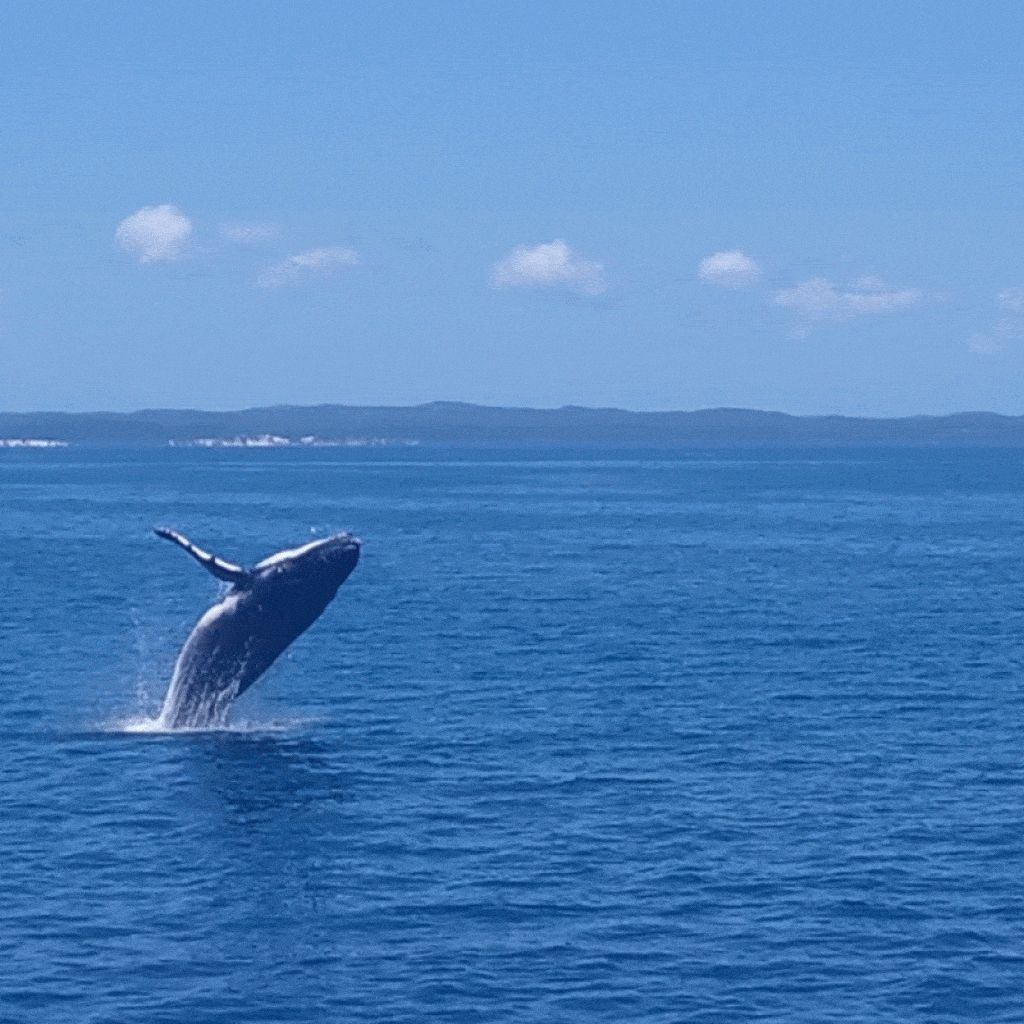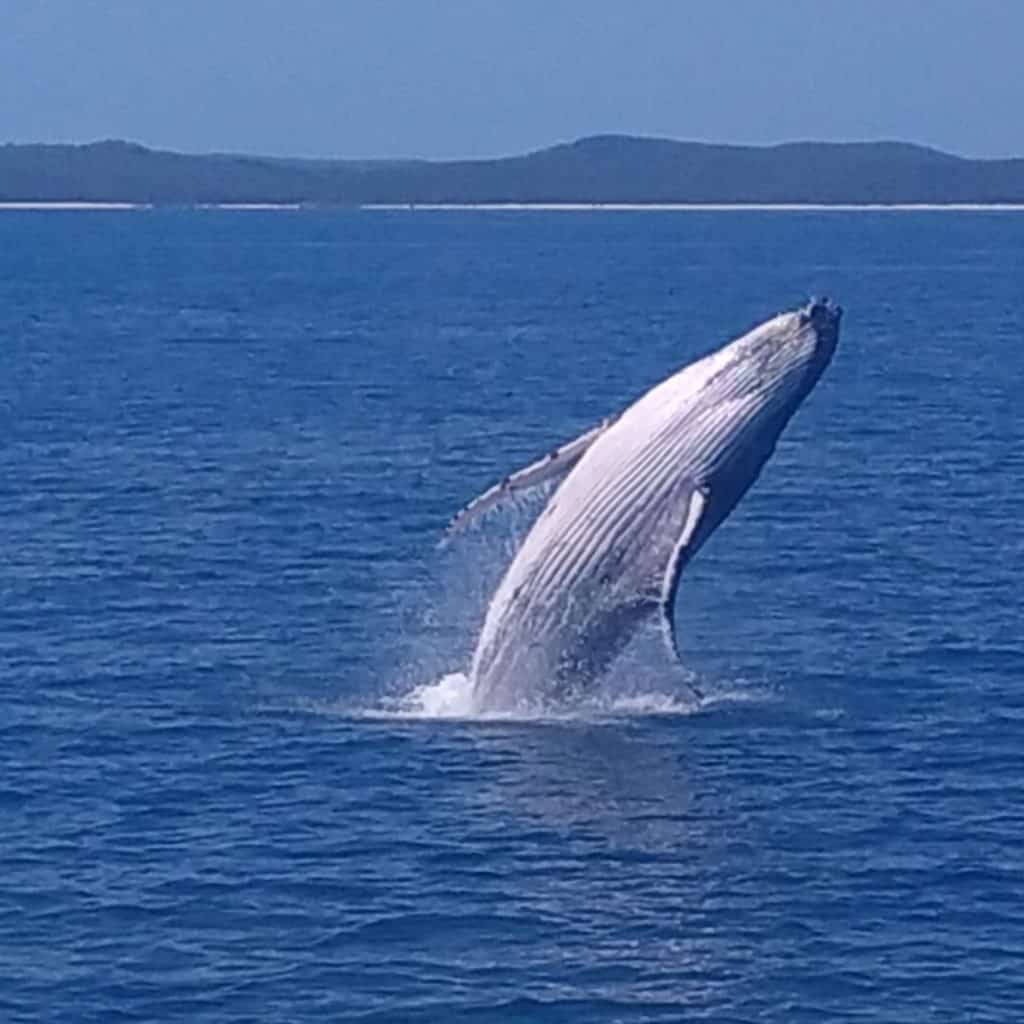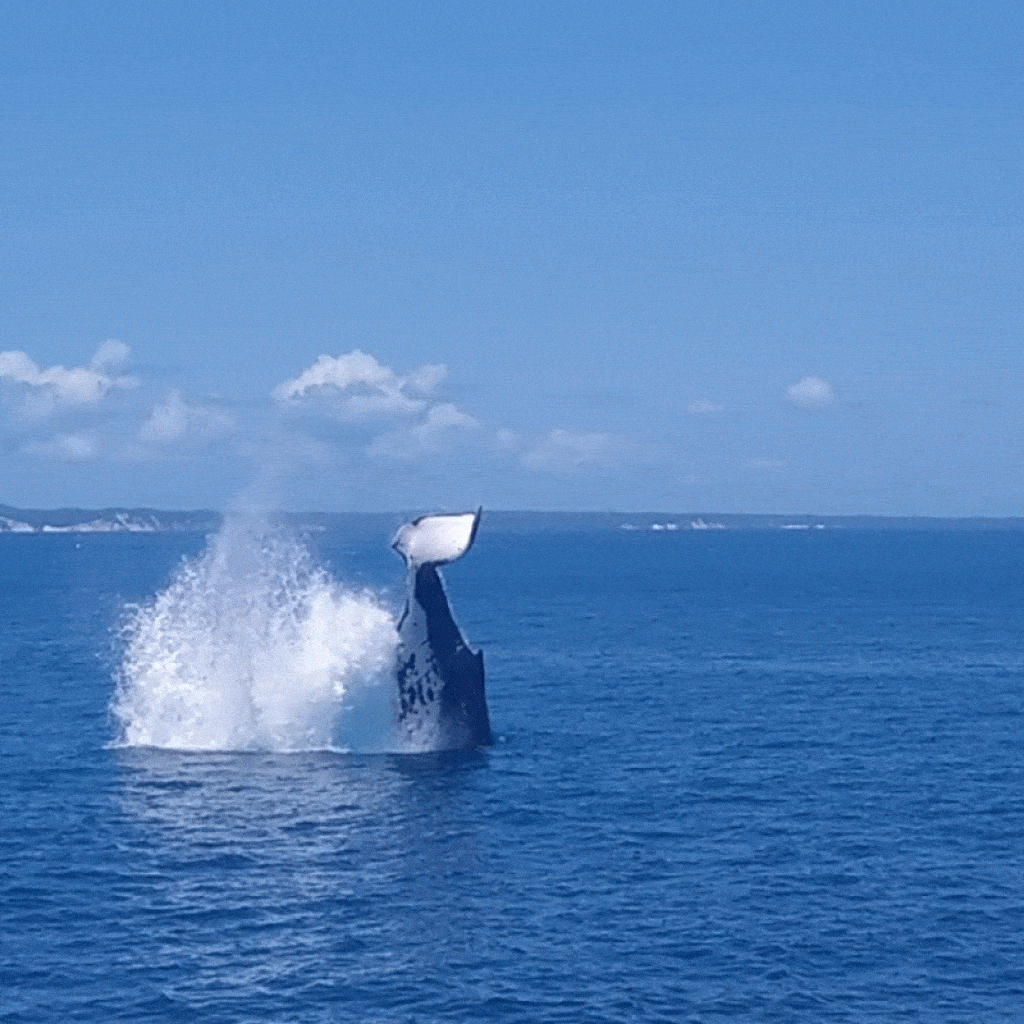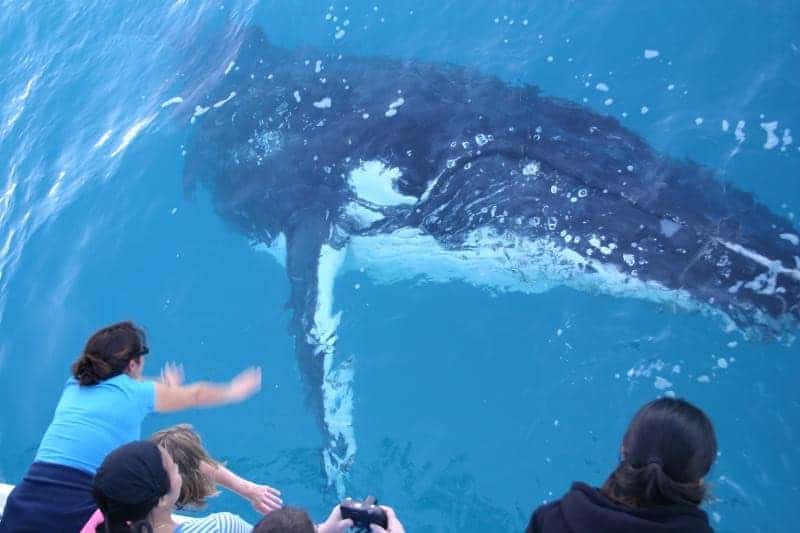The humpback whale earned its name due to the way it bends when diving. The humpbacks arch their back in a hump-like motion when they are diving. Female humpbacks are known to be larger than male counterparts.
They can be recognized by their hump and pectoral fins. The scientific name for the humpback
The dorsal fin sits towards the back of the hump. The typical humpback is black or grey, with white undersides.
Another unique feature of the humpback is the bumps on the head and sides of the flippers. It is said that these tubercles help aid them in confrontations.
These tubercles are often compared to knuckles on a hand. The long fins allow them to maneuver through the water.
Acrobatic Humpback Whale

The most acrobatic of all whales is the majestic humpback whale. This baleen whale can perform up to 15 different acrobatic moves which include the act of breaching.
Breaching happens when the massive creature propels its body completely out of the water and returns to the water with a big splash.
The breaching movement is what sets this species apart from all other baleen whales. Their long fins also set them apart from any other species of cetacean.
The humpback uses their flukes (tail) to playfully splash around in the water, whether it is twisting their bodies and slamming about or to rise out of the water.
The flukes control the movements for the humpback whale. They may splash their tail about to capture prey or to exude dominance.
Socially, the humpbacks will congregate in groups of no more than 5, or they will stay to themselves. However, in certain regions, the number in the pod (a group of whales) has been known to be as high as 15.
This number is dependent upon if the whale is in migration. When interacting with other humpbacks, they can be observed rubbing bodies, patting or slapping the surface with their flippers, or rolling their tails.
Physical Characteristics
A mature adult humpback can reach between 49 to 60 feet (12-18 meters) in length and weigh anywhere from 35 to 50 tons (22,000-30,000 kgs). Depending on the region that the humpback whale is from, and the gender, contributes to its size.
They are found in all oceans north and south of the equator.

I bet you are asking so just how much do humpback whales weigh? Well, the average weight is around the 30,000Kg mark for an adult humpback whale, below you can see the other weights of the most popular whales found in the ocean.
| Whale Types | Weight in Kg |
| Sperm Whales | 35,000 – 37,000Kg |
| Blue Whales | 50,000 – 150,000Kg |
| Fin Whales | 48,000Kg |
| Sei Whales | 20,000Kg |
| Bryde’s Whales | 30,000Kg |
| Minke Whales | 5,600Kg |
| Grey Whales | 27,000Kg |
| North Pacific Right Whales | 40,000 – 70,000Kg |
| Bowhead Whales | 100,000Kg |
| Humpback Whales | 30,000Kg |
| Killer Whales (males) | 3,600 – 5,400Kg |
| – Females | 1,400 – 2,700Kg |
| Beluga Whales | 1,400Kg |
| Short-finned Pilot Whale | 1,000 – 3,000Kg |
| Long-Finned Pilot Whale | 800Kg |
The different populations do not interact with one another due to migration schedules. The speed of a humpback is at the rate of 5 mph (7 km) but can fall as low as 1 mph (1.6 km).
There are times when the speed does increase to 15-16 mph (25 km), particularly in the event of danger. The speed of 3-9 mph (5-15 km) allows for the whales to interact with tour boats and whale watchers.
Behaviours Of The Humpback
The humpback whale uses its movement in the water as a way to depict their behaviour or action. Most aggressiveness comes from competition, this could be with mating or for food.
The humpback may also be shrugging off parasites during these bodily gestures.
When showing protective behaviour there will be body thrashing, tail lashing and lobtailing. The humpback is known for spy-hopping, this is where the whale will poke its head at the surface of the water using its tail to hold the head in a vertical position.
It is said that this is to look for predators to get a feel of the environment.
Logging is when the humpback is in a resting position at the surface of the water, appearing like a log. It is similar to the way they may appear when socializing.
Socializing behaviour is known as milling. Often these two behaviours are mistaken for one another.
This position is used when humpbacks are considered to be resting or sleeping, yet they can only rest for around 30 mins at a time.
In spite of their size, they must remain active for safety reasons. Inactivity causes the humpback whale’s body temperature to drop.
There are specific behaviours that are used by the humpback when they are attempting to attract a mate or show irritation.
This usually involves peduncle throws which is a sign of aggression. This gesture indicates a female is annoyed at a male escort or a male escort is thwarting off a male challenger.
A pectoral slapping gesture involves the whale turning to its side and exposing the fin as it slaps about in the water.
Females may perform this gesture to attract a mate. It can also be a form of playful communication between a calf and mother.
How Does A whale Feed?

The summer months are when the humpback will feed, and increase fat reserves in their bodies to survive the winter months.
The diet consists of up to 3,000 pounds (1360 kgs) of krill, plankton, and small fish. Instead of teeth, they have what is known is baleen, which are white plates of blades composed of keratin.
They use a variety of methods to catch their prey, the most common being the bubble net. The bubbling net is a method where schools of fish are targeted with circling bubbles.
This is often done in groups of humpbacks, where they might let out a shrieking noise to distract the fish or prey. The whale takes one gulp and pushes water through the baleen. This allows the prey to be filtered out of the mouth.
Another method used to capture prey is a slapping motion with their tails against the water. If they fail after a few attempts using this method, then they will resort to the bubbling net technique.
Ring of foam- is a technique that is used when they surround their prey with a ring of foam.
This is done by using their flukes and splashing against the water. Once the foam appears to surround the prey, they will go under the surface and reappear capturing the subdued prey.
The humpback whales form bubble clouds through the exhalation process while breathing. When the bubble clouds are formed, it allows prey to easily be detected.
Bubble columns are formed in the same manner, yet rows or circles are formed instead of clouds.
Where Do Humpback Whales Migrate To And From?
Humpback whales will travel anywhere from 3000 to 6000 km on average during migrating season. The primary reason for migrating is to eat and breed in the areas of water deemed as being safe. They migrate towards colder pools of water in order to eat.
Cooler water carries more nutrients for eating with an overabundance of food, albeit, the frigid cold waters are unwelcoming for giving birth since the calves do not attain their protective blubber until after birth.
Without this protective layer, the calves are unable to survive in colder water.
Calves nurse up to a year and don’t reach full adulthood until 10 years of age. The mother’s milk produces extremely high amounts of fat, protein, lactose and other nutrients the young calves need.
These calves will go through 400 to 500 litres of milk daily.
This again, is what is needed in order to provide the calf with the extra protective layer of blubber, to keep it warm and to store body fat.
The calf and mother use affectionate forms of touching with the flippers to communicate and are known to swim close together until they are out of the nursing period.
Where Do Humpback Whales Breed?
In regards to breeding and mating, the humpback whale is considered a polygamous mammal. Therefore, male and females may have multiple partners in one mating season.
To support this statement, several studies have been performed obtaining samples from the mother and various offspring, which concluded that there were multiple fathers to the offspring.
The average age for sexual maturity is between the ages of 4-7 and females will breed every 2 years. The gestation period is from 11 to 11.5 months, nursing is up to a year although weaning begins between 4-5 months.
During this period the calves are being prepared to feed and perform the migration route without the mother.
The mating period is between October and March when they are in warmer waters. The male humpbacks-also known as bulls use mating songs and violent displays of dominance to attract a mate.
Once the female has chosen a mate, the courtship begins.
There is a fierce competition when it comes to mating, although there is no emotional connection or bond between the mates. The only bond is between mother and calf.
There have been said reports of blood baths due to the aggressiveness of the fight for a mate. The whales have been observed lunging headfirst at one another and splashing around attacking one another.
Do Humpback Whales Sing The Same Song?
Humpback males are known for their enchanting melodies that are most prevalent during the mating season. It is said that the males use these unique chants to lure in a mate.
Although females make sounds as well, it is believed this is done to communicate with their calf.
Some scientists believe that the sounds could be to communicate with others indicating their dominance, a form of aggression, or an attraction to a cow(female).
The songs can last up to 20-30 mins and may change subtly each year. Each territory has a distinctive theme that dictates the area or region that they are from.
The sounds, moans, cries, or squeals can be heard over long distances across the ocean.
Researchers have said that the whale’s brain is extremely large and they exude a high level of intelligence, indicative of there various sounds. This is because most of the whale’s brain, processes information through sound.
The humpback is known for having a remarkable sense of hearing, its hearing range can go as far as thousands of miles, provided there is no interference from noise pollution.
How Long Can A Humpback Whale Hold Its Breath?
To breathe, the humpback whale needs to rise to the surface of the water for air. Since the humpback is a mammal, they are unable to breathe underwater because of the need for air. The humpback has blowholes which are the equivalent to nostrils.
Their lungs are filled with air, and the blowholes are used to exhale-releasing warm air. This process is then repeated every 15 minutes for adults and 3-5 minutes for the calves and juveniles.
They can hold their breath for an average of 45 minutes, however, they do need to rise to the surface of the water for oxygen. The blubber is used to store oxygen and humpback whales can store more oxygen than most other animals.
It is said that while sleeping the humpback whale only shuts down part of its brain. They need to be awake and alert to breathe according to many studies.
Whale Exploitation
The humpback whale was highly prized from the 1700s to the 1800s and came close to extinction by 1946. They were sought after for their oil that was extracted from their blubber, and for their teeth.
They have been protected from whaling since the 1960s.
While whaling does exist in certain parts of the world, there have been regulations put in place to protect the species from becoming endangered or extinct. Commercial whaling nearly wiped out the species.
Despite rising numbers in the population, today they are still on the endangered species list.
This whale was an easy target for whaling in those days because of it being known as a slow swimmer. This made it more susceptible to attacks by vessels and harpoons.
Since the implementation of the IWC to monitor the whaling industry, whaling has been categorized into 3 categories:
Commercial whaling – Norway and Iceland are only participating countries as of today. Japan performs whaling within domestic waters.
Aboriginal whaling – Natives around the Arctic and Caribbean can hunt in the manner of commercial whaling. This has been done with powerful and explosive equipment.
Scientific whaling– Provides a grey area to allow permits for commercial whaling.
Despite this, the biggest danger currently for the humpback, is accidents, pollution and predatory attacks from killer whales. Whaling is still present however not as it was in the early 1900s.
Studies have shown that some populations of the humpback have increased by around 90%.
Which, is an impressive count, considering the comeback period for centuries of damage is barely over 40 years. The same attributions that make this whale unique and admired are the same ones that have made it a huge target for commercial whaling.
Humpback Whale Research
There are many techniques performed to research the humpback whale. The distinctive markings on their fluke are what sets each one apart. Photographs of the flukes are used to match the distinctive features to tell the humpbacks apart.
The fluke is observed for pigmentation, distinctive marks or scars and for trailing edge shape. Some of this research is done for analyzing entanglement and studies
Many studies are being done to observe the factors contributing to the increase and population and deaths. Studies are to look at breeding grounds, changes in climate, pollution, life history, and genetics.
Research case studies performed by IWC and CCS have been done to ensure the accuracy of data received. This led to more thorough and detailed methods of research.
Research for the humpback whale is also done through satellite tags. The tags are used to track location and migration habits. These satellite radio transmitters are embedded in the fin of the whale by using a crossbow.
The protective blubber prevents the crossbow from harming the humpback during the administration of the transmitter.
Several projects such as the MONAH, YONAH, and SPLASH have greatly contributed to the recovery of the humpback whale species.
The Humpback Whale Studies Program provides research on molecular genetics through biopsy sampling. This gives more insight into the structure, size, and mating system of the population.
Samples are retrieved after continuous activity from the humpback.
How old Is Migaloo The White Whale?
To see a white humpback whale is extremely rare. There have only been sightings of a total of 5 white humpback whales that have occurred in and around Australia. Migaloo is the name of the most famous albino humpback and has been spotted since 1991.
Migaloo is said to have been born between 1987-1989. There have been sightings of what are thought to be the offspring of Migaloo, however, it is yet to be confirmed.
There have been individual sightings of calves moving about the coastal waters of Australia. In 2018, photos were taken of an albino calf with Migaloo, but reports have not confirmed whether it was an offspring of Migaloo.
The other albino humpbacks, Milo Jr., Willow, and Bahloo are not seen as often as Migaloo. There are even questions if they are true albinos due to the features of the fluke.
They could be suffering from leucism, where parts of the body have a loss of pigmentation. Albinism is a genetic disorder where the hair, body, and eyes lack pigmentation.
Baloo is said to have black patches on the head and tail of its body, whereas Migaloo is all white. Genetic testing was performed on Migaloo, through samples and it was discovered that Migaloo is a true albino.
Perhaps what is considered to be hypo-pigmented. These tests were performed by researchers at Southern Cross University in Australia.
Regardless of if these animals are true albinos or not, these rare creatures are protected under a specialized law in Australia.
A humpback that is 90% white is referred to as a specialized marine mammal. Under the law, a boat or vessel must maintain a distance of 500 meters and aircraft must maintain a distance of 610 meters from the animal.
Why Do Humpback Whales Travel To Hervey Bay Queensland?
The humpback whale migration route to Antarctica includes a stop in Hervey Bay, Queensland. Here the humpback can freely breed and care for their young, out of the eyes of predators. You can find them here from late June until November.
In the early months proceeding the start of the season, you may sporadically find a few humpbacks throughout the water, that is in search of a mating partner without competing with other males.
Older juveniles are the first to be seen at the Bay, followed by mature males. The last to arrive are the mothers and calves, where at times arrive as late as October.
This allows them to get in additional feedings before heading to the warm tropical waters of the Bay since it will be months before they feed again. You can see here by the photos on this page taken in 2019
The Whale Watching Season In Hervey Bay Queensland
Whale watching is when observers gather to view these majestic creatures display behavioural stunts and acrobatics. This can be done from the charter boats or the shore in certain regions.
June 1st is the official start of whale watching season in Hervey Bay, Queensland.
It is a very lucrative industry, individuals flock from all over the world to witness the acrobatics. This is when you will see charter boats and tourists increasing to watch the jaw-dropping moves that the humpbacks perform.
The relaxing activity of whale watching has contributed to economic situations, in what’s referred to as ecotourism.
Where the economy is benefiting from the display and show the humpbacks exhibit, and the whales are not harmed.
In October of 2019, a conference was held in Hervey Bay to look at the improvement of ecotourism, representatives from all over the world including USA, Bahia, New Zealand, Africa, Parts of Europe, Bali, Mexico, Germany, and Canada.
Prior to the conference, Hervey Bay’s Mayor took representatives of Japan on a personal tour of the Whale watching industry in Hervey Bay.
The ORRCA trains individuals in preparation for the whale-watching season for marine mammal rescue. The best time to view the whales during the whale watching season is in the water.
Since they are slow swimmers, there are plenty of opportunities to have up-close views of the majestic creatures. Especially, when viewing from a boat.
A whale count is performed at the end of June every year, to monitor the population of this species. This provides researchers with information regarding attacks, deaths and population births of the humpback.
It is said that the population in the Bay has increased by about 10% every year over the last decade.
Conclusion
Over the years the humpback whale has continued to increase in population, due to various efforts performed to preserve this species. The humpback has a lifespan of 70-90 years based on environmental situations.
There have been some suggestions that the abundance of krill is declining in certain areas, but that it is not expected to negatively affect the humpback at this point, with the way exploitation and whaling affected the population of this species for many centuries.
Continuous research and studies are finding ways to keep preserving and increasing the population of the humpback whale.
Resource Links To Products We Use And Recommend
More Pages On Whales
Hervey Bay is a stunning section of Queensland known for its string of coastal towns along the eastern coast of Australia. It has quiet beaches, access to world heritage sites, fishing opportunities,...
Hervey Bay in Queensland Australia is one of the most iconic places to watch humpback whales. In fact, the area is so popular for its whale-watching, it is known as the whale-watching capital of the...


